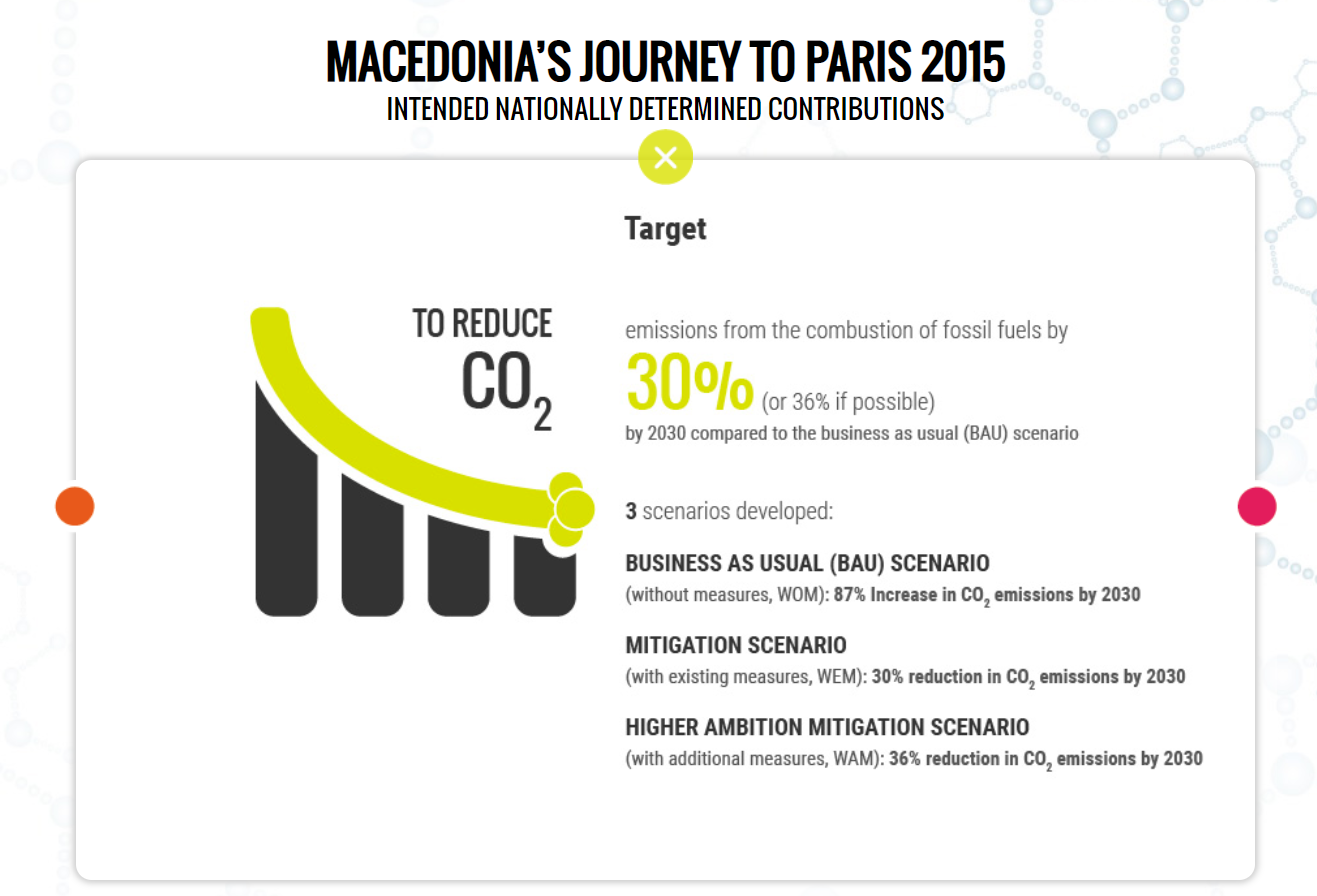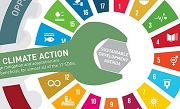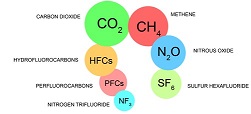Toward more ambitious Nationally Determined Contribution
- {{"article.by"|translate}} Natasa Markovska, RCESD-MASA
- {{"article.posted"|translate}} 24-04-2020
Toward more ambitious Nationally Determined Contribution
The context-changing developments both, at national and at international level are in favor of not only more ambitious, but also well-informed and comprehensive revision of the current Nationally Determined Contribution. Let us see how.
The Republic of North Macedonia, a non-Annex I party to the United Nations Framework Convention on Climate Change (UNFCCC), ratified Paris Agreement in November 2017, with the following contribution to the global efforts for GHG emissions reduction (Macedonian NDC): “To reduce the CO2 emissions from fossil fuels combustion for 30%, that is, for 36% at a higher level of ambition, by 2030 compared to the business as usual (BAU) scenario.” The focus of the Macedonian NDC is put on climate change mitigation, that is, on policies and measures which lead to GHG emissions reduction, and particularly to CO2 emissions from fossil fuels combustion which covers almost 80% of the total GHG emissions in the country. The following sectors are of dominant share: energy supply, buildings and transport.

Source: www.klimatskipromeni.mk
Meanwhile a number of context-changing developments both, at national and at international have occurred which will shape the revised Macedonian NDC. Let us start with the national ones.
Second Biennial Update Report (SBUR) was submitted to the UNFCCC while the Third Biennial Update Report (TBUR) is in final phase of preparation. Also, the National Strategy for Energy Development up to 2040 (Energy Strategy) was adopted in December 2019 and is the first strategy of an Energy Community Country which is based on the five pillars of the EU Energy Union - Security, solidarity and trust; A fully integrated internal energy market; Energy efficiency; Decarbonizing the economy; Research, innovation and competitiveness. Hence, the Energy Strategy depicts three scenarios - Reference, Moderate Transition and Green which reflect different dynamics of energy transition and enable flexibility into Macedonian response to relevant EU policies and governance for modern, competitive and climate-neutral economy by 2050.
All these documents are based on the robust analytical work and consultations with the relevant ministries and other relevant stakeholders aimed at identification and validation of possible mitigation policies and measures in the target sectors, prioritization of identified policies and measures and providing directions for development of mitigation scenarios, as well as, identification and validation of the assumptions used for the modelling of scenarios. Therefore, it can be safely concluded that the capacity, both analytical and institutional, and the participatory process, which have been created even before the Macedonian NDC, and maintained and enhanced over the SBUR, Energy strategy and the TBUR timelines are strong entry points for the forthcoming revision of the NDC.
In terms of the deliveries of these documents, there are four things worth mentioning.
| Firstly, Macedonian SBUR and TBUR besides policies and measures (PAMs) from Energy sector, analyzes and incorporates in their scenarios PAMs from Industry, Agriculture, Forestry and Other Land Use and Waste sectors, which also are important target sectors for climate action. The applied inter- and intra-sectoral approach in modelling of scenarios ensures harvesting the overall mitigation potential in the country. In that way, the Energy and Climate are brought closer together gaining momentum for Integrated Energy and Climate Planning, which is to be duly applied in the ongoing National Energy and Climate Plan (NECP) and the forthcoming revision of the NDC. |
|
| Secondly, stage is set in the TBUR, for analyzing, and equally important, for perceiving the mitigation efforts as contribution to global Agenda 2030 for Sustainable Development. Namely, to each mitigation PAM included in the TBUR mitigation scenarios, additional information is included about its prospective direct and indirect impacts to Sustainable Development Goals (SDGs). In that way, during the Monitoring, Reporting and Verification (MRV) phase, besides performance assessment through progress indicators of the mitigation PAMs, their contribution to SD agenda in the country can be quantified. In addition, a number of specific SDG indicators are projected based on the TBUR mitigation scenarios, enabling thus a comparative assessment of the future state in the country against the current state of some countries in the region and EU. Again, this is very useful exercise which enables informed debate and understanding where the mitigation action would lead the Macedonian economy one or two decades from now. |
|
| Thirdly, although conducted even for the original NDC, quantification of co-benefits of mitigation action is also integrated in the TBUR mitigation analyses specifying the time series of the jobs created by mitigation PAMs. Same as the above, the identified job creation potential will enable the marketing and promotion of the mitigation action. Worth mentioning in this regard, is the Study on Transport (STUTRA) and the Study on the Heating in the City of Skopje (STUGRES) conducted under SBUR. The last, certainly has a significant role to play when it comes to mitigation action at local level. Gender aspect is another social aspect broadly addressed in the TBUR, including an action plan on gender and climate change and gender-sensitive indicators measuring the effect of policies/actions on women. |
|
| Finally, the fourth noteworthy delivery is the latest GHG inventory, which goes well beyond the requirements for non-Annex I countries with well-established and functional Quality Assurance/Quality Control system, and quite ambitious practices of application of higher Tier methodologies and coverage of GHG and non-GHG gases. Therefore, the Macedonian GHG inventory provides robust historical base for the assumptions and emissions projections which are essential elements for informed revised NDC. |
Furthermore, at national level, worth mentioning as contribution and entry point to the revised NDC is the ongoing project entitled “Law and Strategy on Climate Change,” which has been programmed under the EU Instrument for Pre-Accession Assistance (IPA II) funding mechanism and is to deliver the Long-term Climate Action Strategy and a Law on Climate Action . Also, the country has commenced preparation of its National Energy and Climate Plan (NECP) which will be based on the Enhanced Scenario with Additional Measures (e-WAM) from the TBUR, or in other words, Green Scenario from Energy Strategy augmented with the PAMs from the Industry, Agriculture, Forestry and Other Land Use and Waste sectors.
Internationally, under Paris Agreement, an invitation to the parties is issued to pursue the efforts for keeping global warming to 1.5°C compared to pre-industrial levels. The parties will have to respond with considerably enhanced NDCs. Also, international support for NDC revision is made available to the countries, such as UNDP support through Climate Promise initiative. As an example of enhanced ambition is the European Commission which presented a long-term strategic vision to reduce greenhouse gas emissions, showing how Europe can lead the way to climate neutrality by midcentury – an economy with net-zero GHG emissions. The EU ambition should be reflected adequately in the contributions of the aspiring countries for EU membership.
Furthermore, the energy transition is happening with an accelerated pace - renewables are growing fastest even as fossil fuels continue to dominate and clean technologies are opening up major new opportunities for industry and investors, even if capital markets are slower to align with the climate economy. Both solar and wind power are becoming significantly more competitive. On top, the sinking demand for oil caused by the coronavirus pandemic combined with a cruel price war has left the fossil fuel industry broken and in survival mode. It seems that with COVID-19 the world was just handed a once in a lifetime opportunity to fundamentally alter the energy landscape.
Definitely, the revised Macedonian NDC will capitalize on the capacities, participatory practice, experience, tools and knowledge base that have been created even before the original Macedonian NDC, and maintained and enhanced over the SBUR, Energy Strategy and the TBUR timelines. The elaborated national and international developments have open up possibilities for more ambitious contribution in terms of expected GHG emission reductions since it can articulate economy-wide target with mitigation PAMs from all GHG emitting sectors and covering all GHGs. For Energy sector, it can be based on the most ambitious scenario from the Energy Strategy, that is the Green scenario (lots of renewables and enhanced energy efficiency). The target setting can be well-informed by the existing robust and comprehensive GHG inventory. Furthermore, the revised Macedonian NDC can weave the sustainable development into its PAMs, showing the synergies between sustainable development and climate change mitigation. It can create possibility to quantify the contribution of the mitigation action to the national SD agenda, particularly to its social dimension through jobs created with realization of the mitigation PAMs. Last but not least, the current accomplishments regrading gender aspect will help fostering not only gender sensitive, but also gender responsive NDC.
Goes without saying that the partnership science – policy-making, supported by all relevant stakeholders, is a prerequisite for informed, ambitious and comprehensive NDC. In Macedonian case, this partnership and cooperation with the stakeholders have been nurtured since the beginning. No reason not to be so with the revised Macedonian NDC.
-
Корисни линкови
26-01-2021 -
Справување со климатските промени и загадувањето на воздухот во градот Скопје
29-04-2018 -
Финансирање во климата
28-01-2022 -
Микронаративи
08-06-2022
{{"article.lastestPosts"|translate}}
-
Нови финансирања за унапредување на природата и биолошката разновидност на Зелената агенда за Западен Балкан
11-03-2025 -
Започна проектот за развој на 1-от и 2-от двогодишен извештај за транспарентност и 5-от национален извештај за климатски промени на С.Македонија
04-03-2025 -
Земјоделски форум за климатски промени: Се изнаоѓаат решенија за поголема климатска отпроност на заемјоделието
02-12-2024 -
Заврши COP29, центарален фокус на финасирањето за климата
02-12-2024









 Мод за знаковен јазик
Мод за знаковен јазик Говорен асистент
Говорен асистент Означи линкови
Означи линкови

 Зголеми маус
Зголеми маус